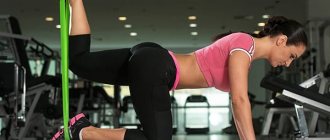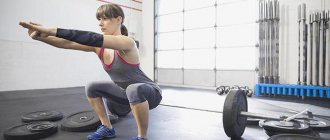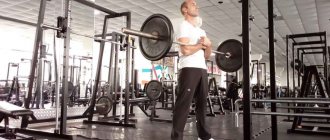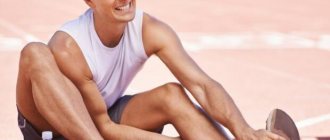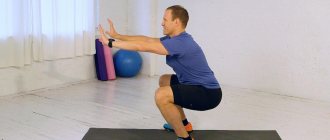Sumo squats are an effective exercise for training the buttocks and adductor surface of the thigh; it will be relevant not only for the fair half of humanity, but also for men, this type of squats is also useful, since with a certain placement of the feet, the load also falls on the quadriceps. The exercise does not involve additional muscles that stabilize the body position, which can be considered an advantage. Squats are performed not only with a barbell, but also with a dumbbell and in a Smith machine. So, what are sumo squats and whether this type of load should be included in the training process, we will find out right now!
Benefits and Disadvantages of Sumo Squats
This exercise is suitable for both men and girls due to its active effect on the muscles of the lower body. When performing sumo squats, those muscles are used that are not used in the classical squat technique. It is also worth noting the following advantages of sumo squats:
- Complex work of the muscles of the legs and buttocks.
- Effective work of the adductor muscles, which is a very relevant activity in women's training.
- Improves hip flexibility and mobility.
- Effectively improves blood circulation in the legs and pelvic organs.
- Ability to work with various weights and sports equipment (barbell, dumbbell, kettlebell, bag and other equipment).
- Sumo squats are suitable for a home exercise routine.
- By reducing the inclination with a dumbbell, the load on the lower back is reduced.
Of course, there are also disadvantages.
- For example, the technique of performing sumo squats is somewhat more complicated than the classic version. In this case, you need to squat widely and carefully ensure that your knees do not bend inward. To do this, you need to use a light weight, at least at first.
- It is also worth noting that sumo squats place a significant load on the knee and hip joints, which, by the way, are in an unusual position throughout the entire range of motion.
Squats with wide legs: video
How to perform the wide squat exercise? Technique
- Starting position : standing with your feet wide, holding a dumbbell in your hands. The toes of the feet are slightly turned to the sides. The back is straight. The knees are slightly bent.
- Lower the dumbbell down until it lightly touches the floor. Inhale as you move.
- Rise back up to the starting position, exhaling.
- Repeat wide squats 15 times in 3 sets. Rest 90 seconds between sets.
How to perform the wide squat exercise? Technique
Application of the exercise
For whom . Everyone from beginner to master.
It is more recommended for girls and women to get good shape of the thigh muscles and buttocks.
When . Wide-set squats are best done at the beginning of your workout. After squats, do your legs in the simulator and straighten your legs.
How many . It is recommended to do the exercise in 3 sets of 15-20 repetitions. To grow leg muscles, do 4 sets of 12 repetitions.
Adviсe
- Fix your knees and try to hold them without moving them to the sides or forward.
- Do squats slowly and lifts twice as fast.
- Select the weight of the weight so that you can feel the inner thighs working.
What muscles work in sumo squats?
The exercise affects the following muscles:
- Adductor muscles of the thigh.
- Quadriceps femoris muscles.
- Large gluteal muscles.
Indirectly and to a lesser extent, the hamstrings are involved, as well as the spinal stabilizer muscles, back muscles, abdominal muscles and calf muscles.
How much to squat and how long can it take to pump up your buttocks?
Many girls are interested in how many times they need to squat to pump up their butt, but the answer to this question will not be specific. Everything happens individually for each person, the process depends on the level of physical fitness, muscle condition, the presence of fat deposits, as well as motivation, regularity of training, their quality, adherence to technique, etc.
Let’s say right away that it is impossible to pump up your buttocks with squats in 10 days, as numerous fitness programs on the Internet promise. To the question whether it is possible to pump up your butt only by doing squats at home in a month, we also will not answer positively - the nut requires a variety of exercises. However, squats may well be the main ones in the complex.
It is possible to improve the shape of your buttocks in a month, but for this it is important to adhere to the following rules:
- Choose a good set of exercises and strictly adhere to the plan;
- You should squat in several approaches. At the same time, in order to burn excess weight, it is important to work at speed, at a pace, constantly increasing the number of approaches and repetitions. To build up mass, you should squat slowly, but efficiently, stopping at the bottom point. The number of repetitions in an approach can be only 10-15, but the weight taken is significant.
- Watch your diet - exclude sugar, simple carbohydrates, fast food, and processed foods. Eat more protein, fruits, vegetables, grains, nuts.
- Add other exercises to pump up the buttocks to the set of classes: scissors, walking on the buttocks, cycling, jumping, walking on a hill, lunges.
- To quickly pump up your butt, it is important to do squats correctly, and therefore, pay attention to the technique;
- Never neglect warming up - it prepares the buttocks for work, warms up the muscles and joints, and reduces the risk of pain after training;
- Motivate yourself and be sure to set goals.
So, it is possible to pump up your butt with squats at home. It is quite possible to get the very first visual result within 30 days after the start of training. What program can I use at the very beginning?
Check out the table of squats for the buttocks at home - this scheme is quite suitable for beginners. Advanced athletes can increase the number of repetitions in their sets or take on additional weight. You need to exercise every day or every other day (if you are a complete beginner). Each new approach can be done with a different type of squat, or you can alternate variations by day.
| A week | 1 approach | 2nd approach | 3 approach | 4 approach |
| 1 | 20 | 15 | 13 | 10 |
| 2 | 30 | 25 | 25 | 20 |
| 3 | 40 | 30 | 30 | 25 |
| 4 | 50 | 40 | 35 | 30 |
Before starting the complex, make sure that you understand exactly how to squat correctly - not only to pump up your butt, but also not to harm your health. Watch thematic videos. Also make sure that you have no contraindications.
Sumo squat technique with a barbell
The barbell sumo squat is similar to the dumbbell technique.
- The athlete must remove the barbell from the rack or frame, spread his legs wide and turn his toes 45 degrees to the sides.
- The bar should rest on the trapezius muscles, as with classic squats.
- During the downward movement, inhale, and during the return movement, exhale.
Please note that your knees should be pointing in the same direction as your feet. The pelvis must be moved back.
Performance technique
So, we looked at what muscles work during sumo squats, and also how they differ from classic squats. Now it's time to figure out how to do sumo squats correctly:
- Initial pose – legs are located at a distance 2-2.5 times wider than shoulders;
- The back is straight throughout the entire exercise, the gaze looks forward or slightly upward;
- The toes are turned out synchronously (beginners can place them parallel);
- Slowly lower yourself down as deeply as possible without bending your knees or arching your back. At this time, take a deep breath;
- As you exhale, rise sharply;
- The weight is held at chest level (kettlebell, dumbbell), on the shoulders (barbell, empty bar), in lowered arms;
- Your knees should point in the same direction as your toes (if they are turned out);
- The wider the socks unfold, the higher the load. Ideally, you should learn to turn your feet 90°;
- When you go down, you can move your pelvis slightly back (without bending your back); when you go up, return to the starting position. This will allow you not to carry your knees by your toes, which significantly reduces the load on the joints;
- When you rise, do not straighten your legs completely.
Sumo squats with a kettlebell for girls are a great way to pump up your legs, make your body contours more prominent, and your butt firm and seductive. But this is not the only benefit that exercise has.
Features and technique of sumo squats with a dumbbell
- Take your starting position, standing straight and maintaining a natural arch in your lower back.
- Your legs should be placed wide apart, your feet should be turned to the sides. The width of the legs is determined individually, since each athlete has different flexibility. In any case, they should be positioned wider than shoulder width.
- It is enough to turn your feet at an angle of 45 degrees.
- At the lowest point of the range of motion, the hips should be parallel to the floor.
- The dumbbells need to be lowered with outstretched arms in front of the body, or you can work with one dumbbell, holding it by the weighting disk, which is much more convenient and minimizes the tilt of the body.
Option 1 - Classic plie squats
Plie squats are performed with a straight back and knees turned out to the sides. When performing plie squats, we sit straight down. Place your feet wider than your shoulders and point your toes to the sides.
Plie squats (step 1)
Bending your legs, slowly lower your pelvis, while your body leans slightly forward, but your back remains straight.
Plie squats (step 2)
At the end point, the hips and pelvis form a parallel line with the floor, the angle at the knee is 90 degrees.
Classic plie squats (sumo) - technique
Recommendations
When performing this type of squats, do not go for too much weight . And it’s better to practice the technique with an empty bar or without any weighting. Another very important point is the depth of the squat. With an amplitude in which the thigh falls below parallel with the floor, the gluteal muscles are more loaded, and the load on the knee joints increases.
Sumo squats for girls
Women should include this exercise in their training as the main possible squat. Of course, you don’t need to ignore classic squats, but sumo squats are considered a priority. You can add glute bridges, wide lunges or Bulgarian lunges to your training complex.
Sumo squats for men
Sumo is not as relevant for men, but it can still be used in leg training. Typically, sumo squats are included as the second or third exercise after performing the main load on the quadriceps.
Here's an example of a leg workout using sumo squats:
- Barbell squats with a classic foot position or leg press with a wide foot position.
- Sumo squats with barbell.
- Lunges with dumbbells (walking).
- Leg extension in the simulator.
- Leg bending in the simulator.
- Exercises for the lower leg muscles.
Butt of dreams
- The Basics: The Classic Barbell Squat
- Still not sure which is better: the barbell squat or the Smith squat? The article “Squats in Smith from A to Z” will answer your question in full!
- Squats at the lower block of the crossover
- “Legs abducting and abducting in a sitting machine”
- Do you want rounded buttocks? Then you need to master the swing and the Wide Bone will help you with this: “Exercises for the buttocks: gluteal swings” and Butt with a shelf: how to lift the buttocks and remove the depressions on the sides of the hips?
- “Glute Bridge: Exploding the Buttocks”
- Analysis of technique, possible mistakes and important nuances of one of the most difficult exercises: “Back lunges or Bulgarian lunges”
- "Romanian barbell deadlift for women"
- Maximize your buttocks: Bulgarian backward lunges
- How to squat correctly to pump up your butt?
- How to remove the ears on the hips and reduce the volume of the legs: top 16 exercises
[Total votes: 3 Average: 5/5]
Bone Wide
This article was reviewed by a certified nutritionist who has a bachelor's degree in nutrition and dietetics, D. G. Veremeev.
Articles are for informational and educational purposes only and are not a substitute for professional medical advice, diagnosis, or treatment. Always consult your physician with any questions you may have about a medical condition.
Contraindications to squats
Such exercises are contraindicated for problems with the lower back, spine and knees. You also don’t need to do it if you have weak core muscles. In any case, the load on such areas should increase over time.
There are a number of common mistakes that some people make with plie squats. This includes straightening the legs at the top, strongly arching the back, looking down or looking down, knees going beyond the toes, and the use of weights that are too heavy. To prevent such mistakes from happening and make the exercise safer and more correct, you need to follow some recommendations from experts:
- When rising from a squat position, you should try not to straighten your legs completely, as this will put a lot of stress on the knee and reduce overall tension in the muscles.
- When performing squats, it is very important to pay special attention to the correct technique. It is better to take less weight, but from a technical point of view, do everything correctly.
- The knee joint should move in the direction of the toe of the foot, without being limited by its general plane. It will be easy to avoid such a mistake - move your pelvis back, as the technique of this exercise suggests.
- When doing squats, look straight or slightly up. This will help control the load in your hands.
- If the general position of the back is incorrect, there is a risk of injury to the lower area. To prevent this, you need to constantly keep your spine straight.
- The vertical position of the spine is typical when squatting. The correct exercise technique involves moving your pelvis as far back as possible, as if you were trying to sit down on an imaginary chair, while tilting your body slightly forward.
Also during squats you need:
- The amplitude range is considered an individual parameter for everyone. Squats can be deep, as well as with a reduced range of motion. The main tactics in this case are given to the training goal. If you want to work the muscles of the buttocks, then you need to squat low and deep. If you move more than parallel, then it is the quadriceps muscles that will be worked.
- Also, the muscles that will take part in the exercise directly depend on the rotation of the feet and knees. The external orientation pumps up the adductor muscles more, and when the toes are brought together, the load goes to the quadriceps, which is why the exercise loses its effectiveness. You need to turn your toes at an angle of 45 degrees. But with the correct squatting technique, this can be noticeably corrected.
- As with other squats, the sumo technique greatly affects the lumbar region of the back, which is why if you perform the exercise, you need to further strengthen this area using hyperextension.
- There is no need to use too heavy loads. You can understand that you have overdone it this way: if during the normal course of the exercise you make an involuntary jerk with your pelvis, then the weight is too heavy for you.
- At the lowest point, it is best to stop for 2-3 seconds, and then rise sharply and quickly to the starting position.
- To prevent knee injuries from occurring, you need to carefully ensure that your knees are parallel to your feet.
- The weight during squats should be transferred to the heels. This will help to optimally stimulate the gluteal muscles, it will also be rational in terms of biomechanics.
- At this time, you need to keep your back in a level position, arching at the lower back.
- Before performing the exercise, you need to do a little warm-up and stretching. It is important to pay more attention to stretching the inner thigh area.
- Watch your breathing, and perform the main effort during exhalation.
Basic rules of training
In order for training with sumo squats to bring maximum results, experts recommend following these rules:
- Make sure there are no contraindications: problems with joints, lower back, diseases of bone tissue for which intense physical activity is contraindicated, diseases of the cardiovascular system in an acute form.
- Do a warm-up to warm up your joints at the beginning of your workout.
- Be sure to drink water in small sips between sets. The exercise is energy-intensive; when performed, blood flow accelerates and body temperature rises, accordingly a large amount of fluid is lost. Dehydration can lead to poor health and metabolic failure, so it is important to replenish fluid reserves.
- The load should be increased gradually, focusing on your own well-being.
- At the end of the workout, it is recommended to perform stretching exercises to reduce pain from soreness.
- Beginners are recommended to perform sumo squats under the guidance of a fitness instructor. The technique of this exercise is somewhat more complicated than that of classic squats.
- The technique should be developed without weights, and when mastering it, use minimal weight. You can perform a sumo squat with a barbell or dumbbells only when the fitness instructor approves the correct range of motion with your own weight.
- The optimal number of repetitions is 12-15 times when working with heavy weights and 15-20 with medium or light weights.

